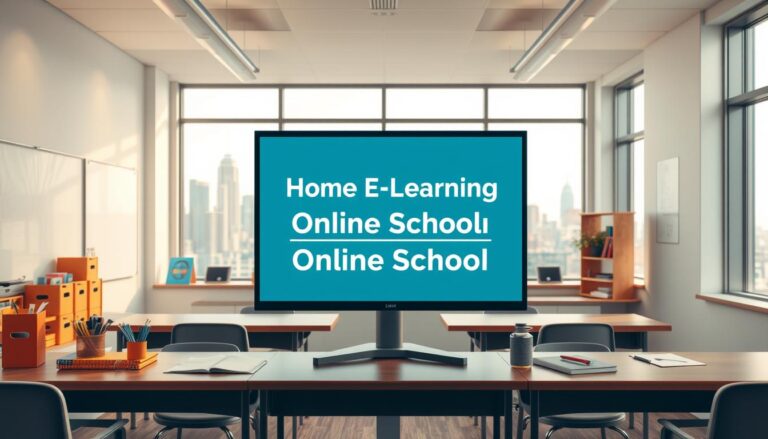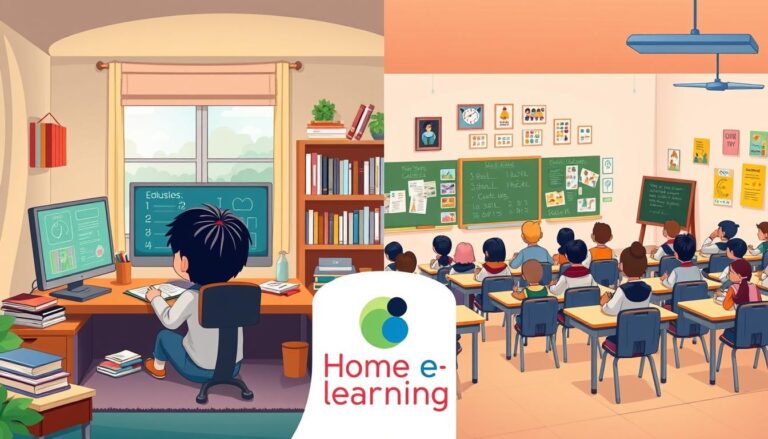Making the Transition from Traditional School to Online School, Online Learning
The world of education is changing fast. Your move from traditional school to online learning is a big change. Now, over 30% of college students in the U.S. take at least one online course.
Switching to online school might seem tough, but it’s very flexible. You can learn from anywhere, without being tied to a specific place. The online education market is expected to hit $375 billion by 2026, showing its big role.
It’s important to understand online learning well. About 70% of students like online courses because they can fit them into their lives. You’ll need to get used to new tech, stay disciplined, and set up a good study space at home.
When you go from offline to online school, think about your tech skills, how you manage time, and staying involved. Online learning lets you learn many subjects at once and get good at using tech.
This change is more than just about tech. It’s about making your learning experience better. With the right mindset, online learning can change your life and open up the world to you.
Understanding the Differences Between Traditional and Online Education
The way we learn is changing fast, with online homeschooling becoming more popular. Technology lets students pick how and where they learn. This means they can find education that really fits their needs.
Key Features of Online Learning Environments
- Flexibility: Online learning provides the flexibility to create a customized schedule that fits your lifestyle. Whether you’re balancing work, family, or other commitments, you can choose when and where to engage with the material.
- Accessibility: One of the greatest advantages of online learning is that it’s accessible from anywhere. You’re not tied to a physical location, making it convenient for learners regardless of where they live.
- Comprehensive Curriculum: Online platforms offer a wide range of rich and diverse learning materials, providing access to quality content that meets various learning needs and preferences.
This structured approach maintains clarity and highlights key points for your readers. Would you like to add more details or examples?
Benefits of Virtual Education
Here are several key benefits of virtual education over traditional schooling:
1. Scheduling
- Benefit: Students can study at their own pace and during hours that fit their personal schedules.
- Explanation: No fixed class times, allowing learners to balance studies with work, family, or other responsibilities.
2. Diverse Course Selection
- Benefit: Online platforms offer a wider range of courses, often including specialized topics not typically available in traditional schools.
- Explanation: Students can explore niche subjects, gain specialized skills, or pursue personal interests more easily.
3. Cost Savings
- Benefit: Virtual education typically eliminates costs like transportation, housing, and meal plans.
- Explanation: Tuition fees are often lower, and students can save money by studying from home.
4. Comfort and Convenience
- Benefit: Students can learn from the comfort of their home, avoiding the need for a daily commute.
- Explanation: Learning in a familiar environment can reduce stress and distractions, boosting focus.
5. Global Access and Networking
- Benefit: Virtual education removes geographic barriers, allowing students from different parts of the world to interact and learn together.
- Explanation: This global classroom experience can expand students’ perspectives and provide unique networking opportunities.
6. Personalized Learning Experience
- Benefit: Online platforms often allow students to customize their learning paths, using multimedia, interactive quizzes, or other resources tailored to their needs.
- Explanation: Adaptive learning technologies can provide real-time feedback and support individualized learning styles.
7. Self-Discipline and Time Management
- Benefit: Virtual education fosters important life skills like self-motivation, time management, and organization.
- Explanation: Students are responsible for setting their own schedule, teaching them how to prioritize tasks and manage their time effectively.
8. Accessibility and Inclusivity
- Benefit: Online education opens doors for students with disabilities, health conditions, or other challenges that make attending traditional schools difficult.
- Explanation: Virtual learning platforms can be designed to be more accessible, with customizable settings for ease of use.
9. Reduced Classroom Distractions
- Benefit: Without the social and environmental distractions often found in traditional classrooms, students can focus more easily on their studies.
- Explanation: Virtual education allows for a controlled, distraction-free environment conducive to learning.
10. Immediate Access to Resources
- Benefit: Online education offers instant access to a wealth of digital resources, such as textbooks, lecture videos, research papers, and discussion forums.
- Explanation: Students can find the information they need quickly and efficiently, enhancing the learning process.
11. Environmental Benefits
- Benefit: Virtual education has a smaller environmental footprint due to reduced travel and less resource consumption.
- Explanation: It eliminates the need for physical infrastructure, saving energy, paper, and other materials.
12. Lifelong Learning
- Benefit: Virtual education supports continuous learning, making it easier for adults to take courses and further their education throughout their lives.
- Explanation: The flexible nature of online learning makes it accessible for individuals who want to upskill or change careers.
These advantages make virtual education an appealing alternative or supplement to traditional schooling, particularly for those seeking flexibility, variety, and accessibility.
Role of Technology in Modern Education
Technology has revolutionized modern education, creating a dynamic and engaging learning environment. It has transformed traditional teaching methods by making learning more interactive and enjoyable. Through tools like educational apps, virtual classrooms, and multimedia content, students can explore concepts in more engaging ways, improving their understanding and retention of information.
Moreover, technology helps students develop essential digital skills, preparing them for the demands of the future job market. These skills, such as coding, digital literacy, and online collaboration, are critical for thriving in a technology-driven world. Ultimately, technology empowers both educators and students, fostering a more flexible, personalized, and future-ready educational experience.
About Home e Learning Online School
Home e Learning is an established online school with five years of experience in providing quality education through engaging virtual classrooms. Known for its interactive and student-centered approach, the platform helps learners grow academically while maintaining high educational standards. The school offers a wide range of courses, designed to meet the diverse needs of students, with personalized instruction that caters to individual learning styles. Using modern teaching techniques and innovative tools, Home e Learning ensures that learning is both effective and enjoyable. With flexible scheduling options, students can balance their studies with personal commitments, making it a convenient choice for families. Trusted for its excellence and dedication to student success, Home e Learning has become a leading option for online education.
Offline to Online School: Essential Steps for a Smooth Transition
Switching from traditional school to online can be tough for students and parents. It needs careful planning to adjust to online learning. This helps ease the move from a classroom to a virtual setting.
First, set up a good school area at home. Choose a quiet spot with few distractions, like a classroom. Make sure you have fast internet, a comfy chair, and all digital tools needed for online classes.
Make a daily routine like school hours. This keeps students disciplined and on track in online classes. Plan study times, use a digital calendar for tasks, and learn to manage your time well.
Get your tech ready. Check your computer, install needed software, and learn the online platform. Many programs offer sessions to help you get used to digital classrooms.
Keep up with friends, even online. Join online forums, group projects, and study groups. About 75% of students find it hard to connect online, so it’s important to stay involved.
Talk often with teachers and classmates. Find ways to ask questions and stay in touch. Regular updates help you see how you’re doing and solve any problems in online classes.
With these steps, you can smoothly move from public school to online learning. You’ll keep up with your studies and grow personally.
Conclusion
Online classes need careful planning and being flexible. The 2024 survey shows 41.6% of learners like online platforms. But, students must understand the special needs of digital learning. You can find online resources to improve your learning methods and get a great educational experience.
Online learning platforms offer great flexibility. You can learn from home and make your education fit your life. With the right tips, you can handle challenges like time management and technical issues that affect about 25% of online students.
Parents and students should see online learning as a chance to grow. The global online education market is expected to hit 1.12 billion users by 2029. By choosing the right online classes and staying disciplined, you can turn limitations into chances for deep learning.
Your success in online education comes from using new learning strategies and digital tools. Home e-learning platforms offer support to help you adjust to this changing educational world. They prepare you for future academic and professional challenges.







